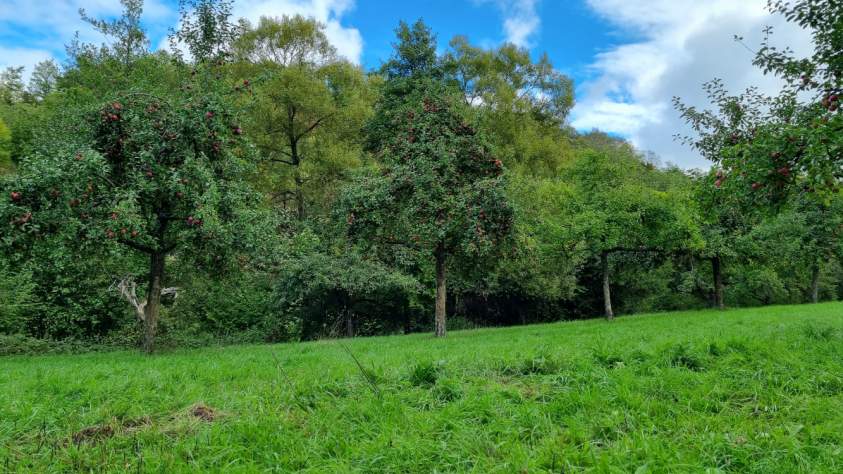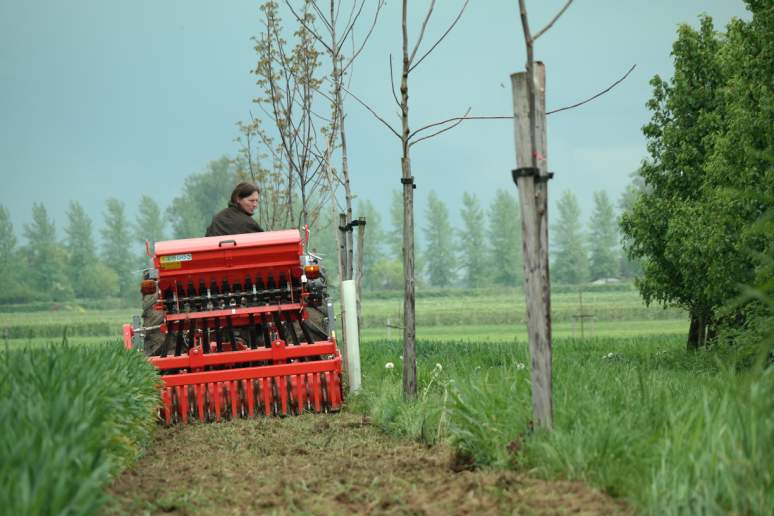Pruning
There are a range of pruning methods required depending on the tree species and planned use or crop. Pruning can, among other things, help: maintain size to make crop picking easier, remove diseased and damaged wood, encourage fruiting, reduce biennial tendencies of some crops, and help grow a clean trunk free of knots for timber.
Choosing the right spacing and design for your planned enterprise can also help to reduce the need for pruning. For instance close planting of nurse trees like alder under timber trees creates shade that forces the timber tree to grow straight and clean without pruning.
Here are the most common forms of tree pruning required.
Fruit and Nut Trees – some formative pruning required to give the tree the right shape and initial growth, followed by annual pruning to balance fruiting and vegetative growth. Dwarf rootstocks require less pruning, and are easier to pick from, but are less resilient in low input systems.
Pruning fruit trees according to an ascending central axis and horizontal side branches has a number of advantages:
- Faster fruit production;
- Fruit can grow more easily on horizontal branches than on steep branches;
- The branches do not grow too heavy making passage with tractor easier;
- Easier pruning;
- Easier harvesting (you can put a ladder against it more easily).
The downside is that the trees tend to grow bigger.

Short rotation coppice – the harvesting of the timber is also the prune. If the trees are part of a browsed system some occasional pruning may be needed to keep the foliage at browse height.
Timber – though many trees grow quicker in agroforestry systems due to reduced competition for light and moisture, this also leads to a bushier tree which if left unpruned will lead to lower value from the tree. Pruning all side branches back to the trunk before they grow to 4 cm diameter, usually up to 10 m depending on market requirements. Specialist pruning equipment may be necessary.
Managing the vegetation under the trees
 Controlling the growth of vegetation under trees is a key tool in successful establishment of trees for agroforestry. It reduces the competition for moisture and light which can hold a tree sapling back when young. There is no single right answer but here are a range of options with their advantage and disadvantage
Controlling the growth of vegetation under trees is a key tool in successful establishment of trees for agroforestry. It reduces the competition for moisture and light which can hold a tree sapling back when young. There is no single right answer but here are a range of options with their advantage and disadvantage
Herbicide – though effective at killing vegetation and cheap and quick, removing entirely the living understory creates bare soil that is vulnerable to drying and erosion providing no protection to tree roots particularly in hot dry springs and summer. It also does nothing to build soil health.
Grazing – with strong staking and guarding close to the tree, or with careful use of electric fencing, grazing almost up to the stem can be an effective way of reducing competition. However there are risks from livestock reaching up to eat the tree branches as they grow, and from trampling around the root zone which can cause compaction.
Mulch mats – effective at controlling annual and some perennial weeds, but fiddly to put down and encourage voles
Woodchip mulch – very effective for annual weeds, moisture retention and improving soil health. More expensive to implement buy proven payback in terms of quicker establishment and increased performance of trees
Physical control – strimming / mowing. Effective at managing the vegetation but little moisture retention benefit. Expensive. Usually used as a last resort if other methods have failed.
Non competitive understory – it is also possible to prepare the planting area in advance and sow a non vigorous grass or clover mix that will not compete with the trees. Though in time more vigorous species will take over, the trees will be well established by then.
Harvesting (wood)
There are a range of harvesting opportunities for trees in agroforestry systems; the first thinnings of timber plantings, final harvest of full grown timber, short rotation coppice for woodchip or woodfuel. For smaller scale a chainsaw is likely to be the most cost effective method, though depending on the number of trees and ease of access to the site, hiring in specialist contractors with larger machinery is an option. Get specialist advice on the value of and markets for larger trees.
Harvesting (fruit)
As with timber the scale of the planting will determine investment in specialist equipment. For most smaller scale operations picking crates and a trailer will be sufficient. Larger operations will require more investment, especially if you are planning to store fruit rather than sell off farm at the point of harvest. Cold storage will also be necessary for soft fruit and for longer storage periods.